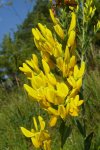Dyk dye - genista tinctoria l.
Family of legumes
Botanical characteristics. Family beans. A low shrub from 30 cm to 1.5 m in height with erect or creeping stems that extend from the rhizome. Stems are paniculate, branched, covered with compressed hairs. Leaves oblong or lanceolate, short-petioled, dark green with pointed stipules. Yellow flowers are collected on the tops of shoots in the multiflorous inflorescence. Blossoms in June-July. The fruit is a flat naked bean up to 30 mm long, ripens in August.
Spread. It grows in the steppe and forest-steppe zones of Russia, in Western Siberia and the Urals, prefers sandy and calcareous slopes, the edges of pine forests.
Used parts of the plant.
The top part of the plant in the flowering phase and the seeds.
The chemical composition is not well understood. Of the gorse, alkaloids - cytisine, genistein and methylcytisine, flavone glyco- sitide luteolin, which is considered to be the main active ingredient, have been isolated.
Application. Droke has a tonic effect, it is used for asthenia and neurocirculatory dystonia of the hypotonic type. The herb has a rather strong diuretic and anti-inflammatory effect, which is why it is prescribed for cardiovascular failure, acute and chronic inflammation of the kidneys and bladder. Drok acts indulgently on the intestines. In folk medicine, grass is used for liver diseases, as well as for hemorrhoids. As a laxative, seeds of gorse are sometimes given (infusion of 1 tablespoon of seeds per 1 cup of boiling water - daily dose).
Contraindications. Some authors consider drock a weakly poisonous plant.
Preparation. Infusion is prepared based on 1 tablespoon of herbs for 2 cups of boiling water (daily dose).




Comments
When commenting on, remember that the content and tone of your message can hurt the feelings of real people, show respect and tolerance to your interlocutors even if you do not share their opinion, your behavior in the conditions of freedom of expression and anonymity provided by the Internet, changes Not only virtual, but also the real world. All comments are hidden from the index, spam is controlled.